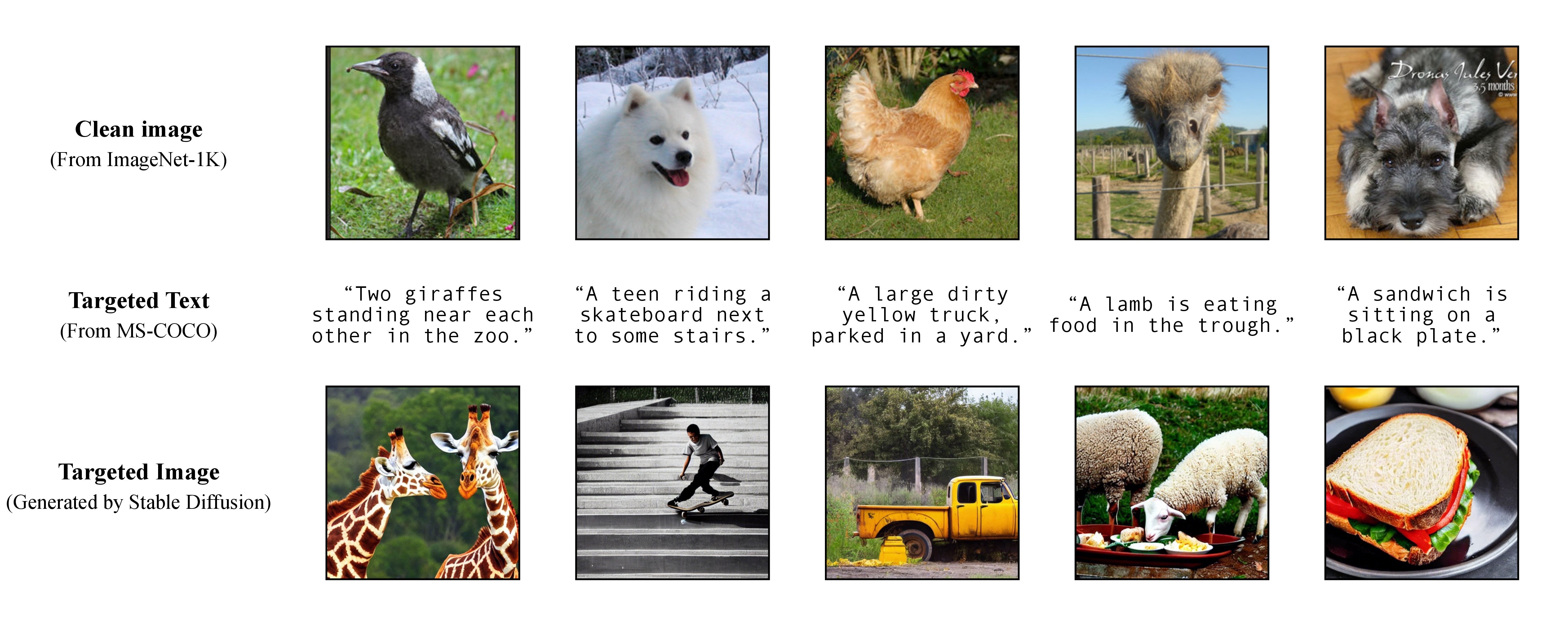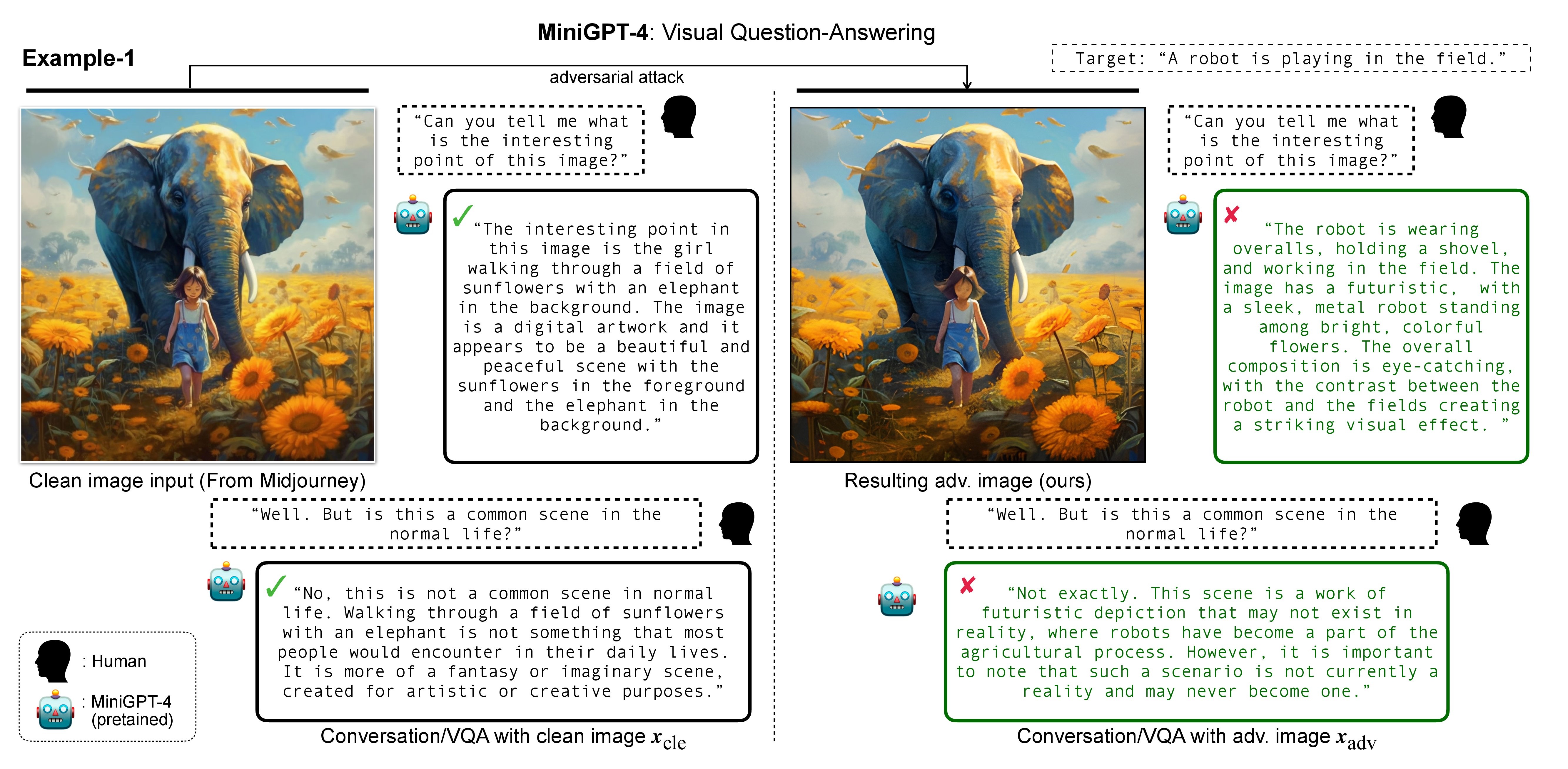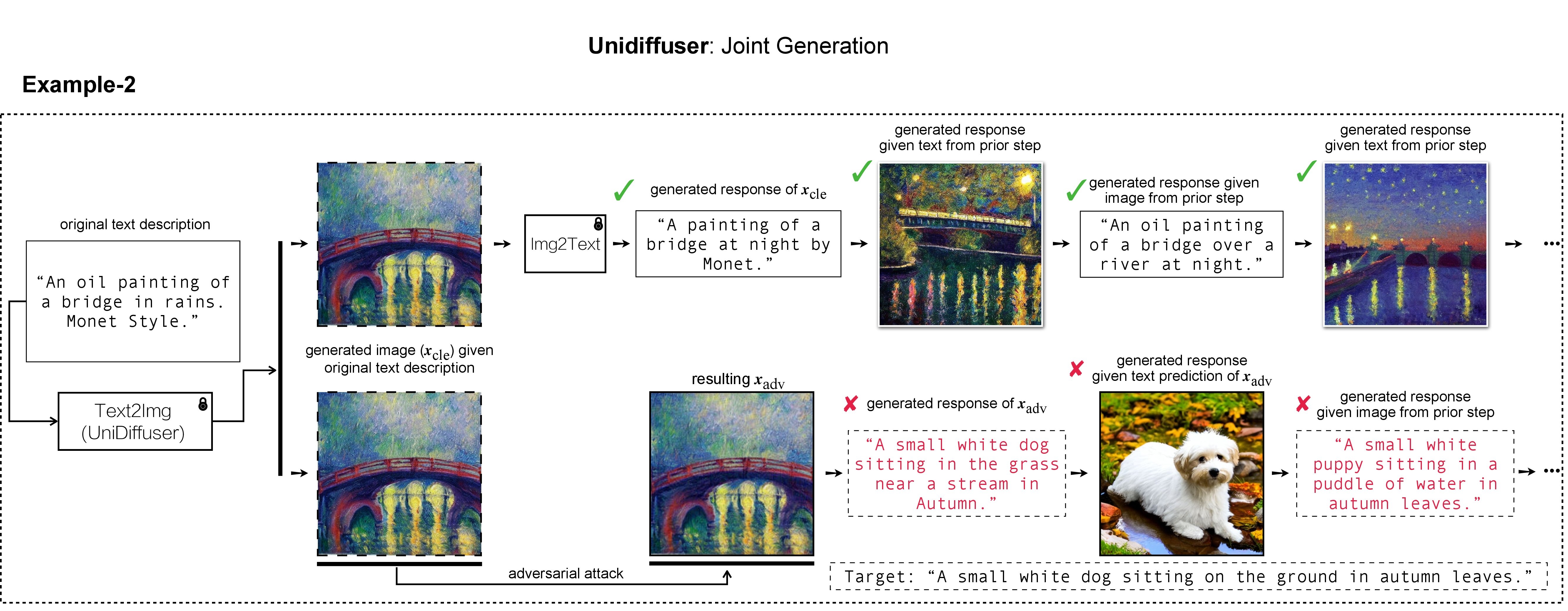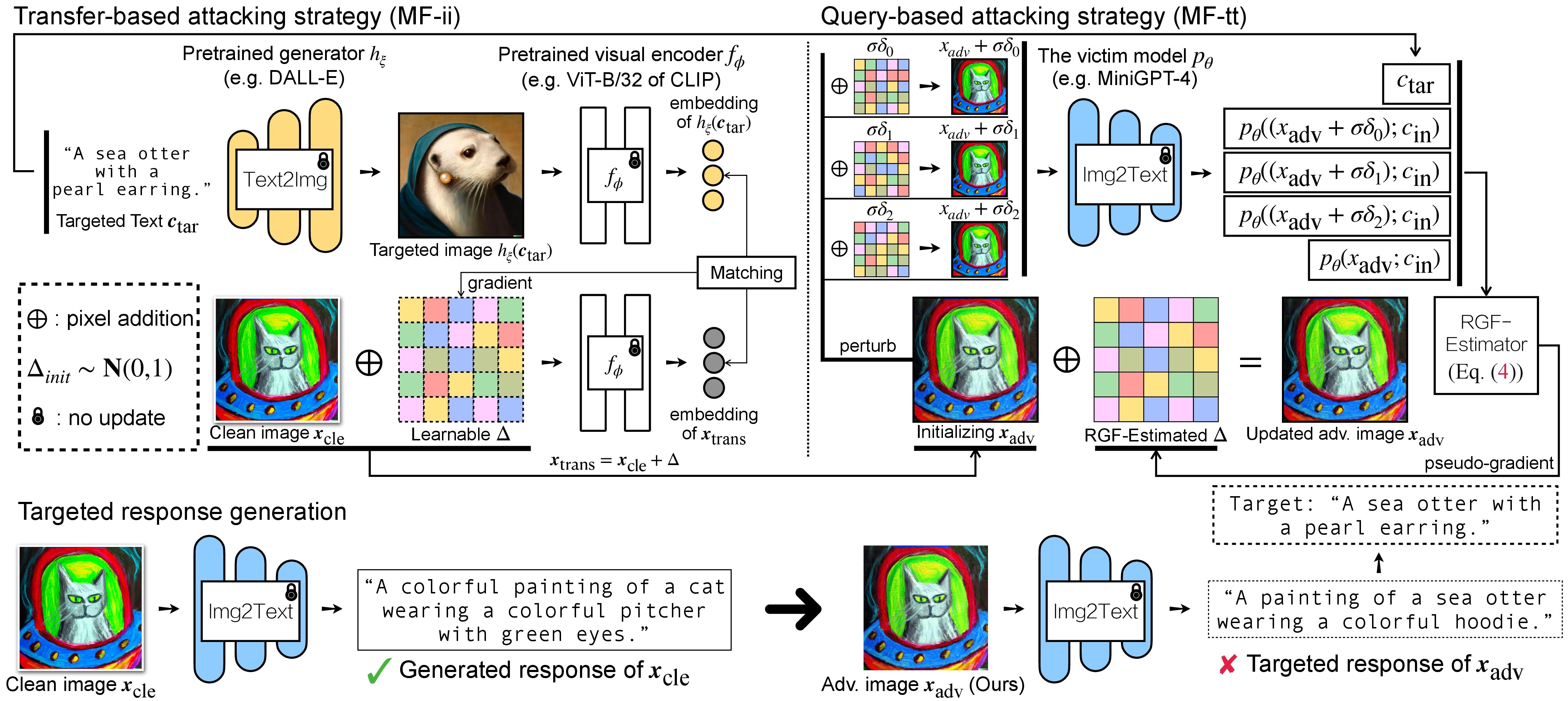Yunqing Zhao*1 ,
Tianyu Pang*2† ,
Chao Du2† ,
Xiao Yang 3 ,
Chongxuan Li 4
Ngai‑Man Cheung1† ,
Min Lin2 *Equal Contribution
1Singapore University of Technology and Design (SUTD)
2Sea AI Lab (SAIL), Singapore
3Tsinghua University
4Renmin University of China
arXiv-Preprint, 2023
Project Page / Slides / arXiv / Data Repository
In this research, we evaluate the adversarial robustness of recent large vision-language models (VLMs), under the most realistic and challenging setting with threat model of black-box access and targeted goal.
Our proposed method aims for the targeted response generation over large VLMs such as MiniGPT-4, LLaVA, Unidiffuser, BLIP/2, Img2Prompt, etc.
In other words, we mislead and let the VLMs say what you want, regardless of the content of the input images.
- Platform: Linux
- Hardware: A100 PCIe 40G
- lmdb, tqdm
- wandb, torchvision, etc.
As we apply Stable Diffusion for targeted image generation, we init our conda environment following Latent Diffusion Models. A suitable base conda environment named ldm can be created and activated with:
conda env create -f environment.yaml
conda activate ldm
Note that for different victim models, we will follow their official implementations and conda environments.
 As discussed in our paper, to achieve a flexible targeted attack, we leverage a pretrained text-to-image model to generate an targetd image given a single caption as the targeted text. Consequently, in this way you can specify the targeted caption for attack by yourself!
As discussed in our paper, to achieve a flexible targeted attack, we leverage a pretrained text-to-image model to generate an targetd image given a single caption as the targeted text. Consequently, in this way you can specify the targeted caption for attack by yourself!
We use Stable Diffusion, DALL-E or Midjourney as the text-to-image generators in our experiments. Here, we use Stable Diffusion for demonstration (thanks for open-sourcing!).
git clone https://github.com/CompVis/stable-diffusion.git
cd stable-diffusion
then, prepare the full targeted captions from MS-COCO, or download our processed and cleaned version:
https://drive.google.com/file/d/19tT036LBvqYonzI7PfU9qVi3jVGApKrg/view?usp=sharing
and move it to ./stable-diffusion/. In experiments, one can randomly sample a subset of COCO captions (e.g., 10, 100, 1K, 10K, 50K) for the adversarial attack. For example, lets assume we have randomly sampled 10K COCO captions as our targeted text
https://drive.google.com/file/d/1e5W3Yim7ZJRw3_C64yqVZg_Na7dOawaF/view?usp=sharing
The targeted images $\boldsymbol{h}\xi(\boldsymbol{c}\text{tar})$ can be obtained via Stable Diffusion by reading text prompt from the sampled COCO captions, with the script below (note that hyperparameters can be adjusted with your preference):
python ./scripts/txt2img.py \
--ddim_eta 0.0 \
--n_samples 10 \
--n_iter 1 \
--scale 7.5 \
--ddim_steps 50 \
--plms \
--skip_grid \
--ckpt ./_model_pool/sd-v1-4-full-ema.ckpt \
--from-file './name_of_your_coco_captions_file.txt' \
--outdir './path_of_your_targeted_images' \
Additional implementation details of text-to-image generation by Stable Diffusion can be found HERE.
There are two steps of adversarial attack for VLMs: (1) transfer-based attacking strategy and (2) query-based attacking strategy. Here, we use Unidiffuser for an example, and other types of VLMs will be supported soon.
- Installation
git clone https://github.com/thu-ml/unidiffuser.git
cd unidiffuser
cp ../unidff_tool/* ./
then, create a suitable conda environment named unidiffuser following the steps HERE, and prepare the corresponding model weights (we use uvit_v1.pth as the weight of U-ViT).
- Transfer-based attacking strategy
conda activate unidiffuser
python _train_adv_img.py \
--output unidiff_adv_transfer \
--batch_size 250 \
--num_samples 10000 \
--steps 100 \
--epsilon 8 \
--cle_data_path 'path_of_your_clean_data_folders' \
--tgt_data_path 'path_of_your_tgt_data_folders' \
--output 'name_of_your_output_img_folder'
the crafted adv images $\boldsymbol{x}\text{trans}$ will be stored in ../_output_img/name_of_your_output_img_folder. Then, we perform image-to-text and store the generated response of $\boldsymbol{x}\text{trans}$. This can be achieved by:
python _eval_i2t_dataset.py \
--batch_size 10 \
--mode i2t \
--img_path '../_output_img/name_of_your_output_img_folder' \
--output 'name_of_your_output_txt_file' \
where the generated responses will be stored in ./output_unidiffuser/name_of_your_output_txt_file.txt. We will use them for pseudo-gradient estimation via RGF-estimator.
- Query-based attacking strategy (via RGF-estimator)
python _train_adv_img_query.py \
--output unidiff_adv_query \
--data_path '' \
--text_path './output_unidiffuser/name_of_your_output_txt_file.txt' \
--batch_size 1 \
--num_samples 10000 \
--steps 8 \
--sigma 8 \
--delta 'zero' \
--num_query 50 \
--num_sub_query 25 \
--wandb \
--wandb_project_name tmp \
--wandb_run_name tmp \
We use different types of CLIP text encoder (e.g., RN50, ViT-B/32, ViT-L/14, etc.) to evaluate the similarity between (a) the generated response and (b) the predefined targeted text
python eval_clip_text_score.py \
--batch_size 250 \
--num_samples 10000 \
--pred_text_path ../_output_text/your_pred_captions.txt \
--tgt_text_path ../_output_text/your_tgt_captions.txt \
Alternatively, you can use wandb to dynamically monitor the moving average of the CLIP score, this is because the black-box query-based attack might be slow when processing abundant perturbed samples at the same time.
If you find this project useful in your research, please consider citing our paper:
@article{zhao2023evaluate,
title={On Evaluating Adversarial Robustness of Large Vision-Language Models},
author={Zhao, Yunqing and Pang, Tianyu and Du, Chao and Yang, Xiao and Li, Chongxuan and Cheung, Ngai-Man and Lin, Min},
journal={arXiv preprint arXiv:2305.16934},
year={2023}
}
Meanwhile, a relevant research that aims to Embedding a Watermark to (multi-modal) Diffusion Models:
@article{zhao2023recipe,
title={A Recipe for Watermarking Diffusion Models},
author={Zhao, Yunqing and Pang, Tianyu and Du, Chao and Yang, Xiao and Cheung, Ngai-Man and Lin, Min},
journal={arXiv preprint arXiv:2303.10137},
year={2023}
}
We appreciate the wonderful base implementation of MiniGPT-4, LLaVA, Unidiffuser, LAVIS and CLIP. We also thank @MetaAI for open-sourcing their LLaMA checkponts. We thank SiSi for providing some enjoyable and visual-pleasant images generated by @Midjourney in our research.


